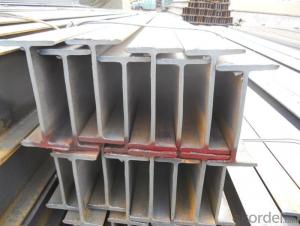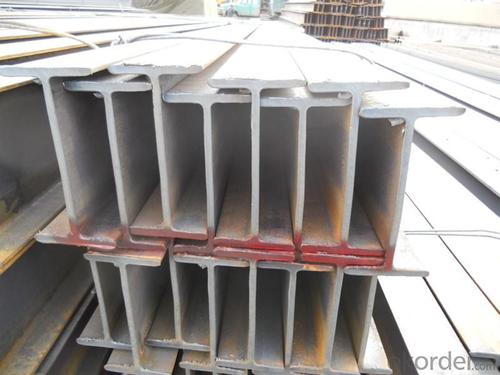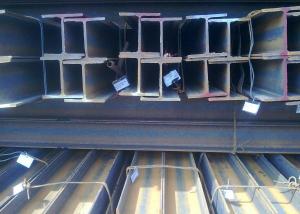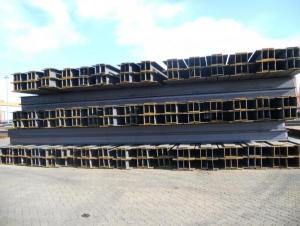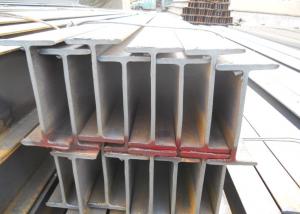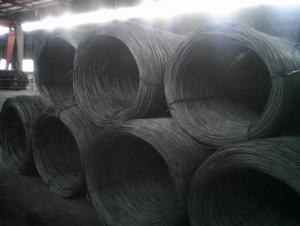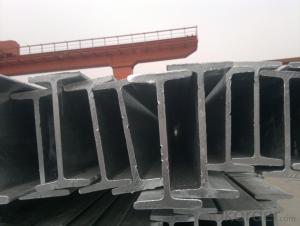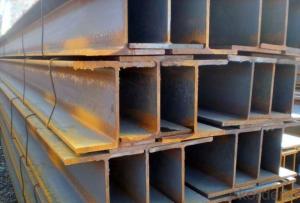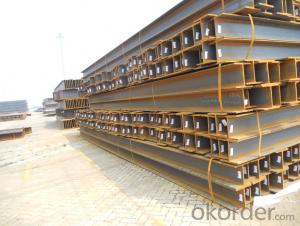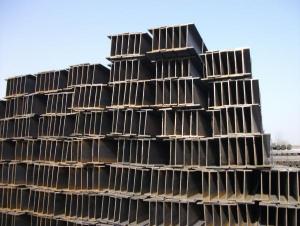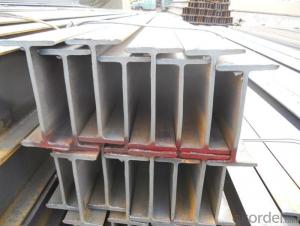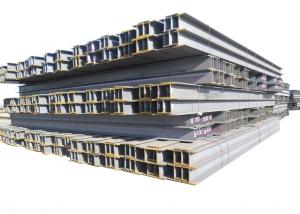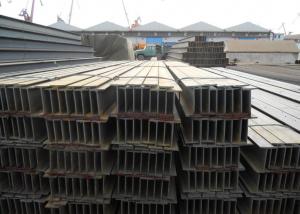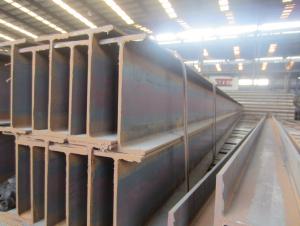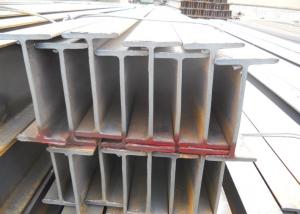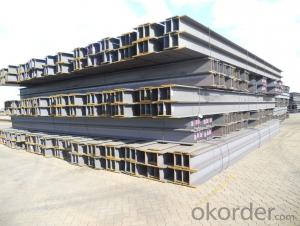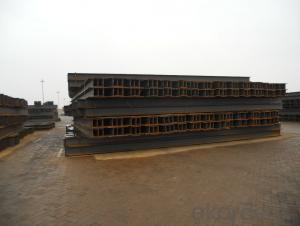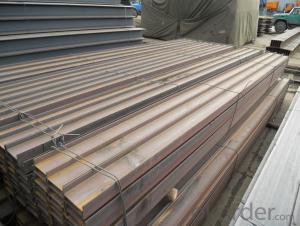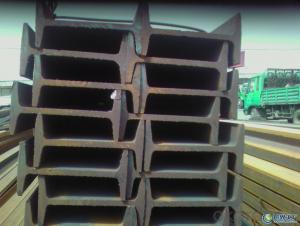Hot Rolled Steel H Beams for Construction of Structures
- Loading Port:
- Tianjin
- Payment Terms:
- TT or LC
- Min Order Qty:
- 50 m.t.
- Supply Capability:
- 10000 m.t./month
OKorder Service Pledge
OKorder Financial Service
You Might Also Like
Product Description:
OKorder is offering Hot Rolled Steel H Beams for Construction of Structures at great prices with worldwide shipping. Our supplier is a world-class manufacturer of steel, with our products utilized the world over. OKorder annually supplies products to African, South American and Asian markets. We provide quotations within 24 hours of receiving an inquiry and guarantee competitive prices.
Product Applications:
Hot Rolled Steel H Beams for Construction of Structures are ideal for structural applications and are widely used inindustrial plants, civil construction, municipal works, oil platforms, bridges, flatbed beams, electrified railway power stand, railway bridges and other light steel structure, super-light H-beam is ideal for containers, mobile homes , all kinds of garage, box-type trains, electrical bracket, various venues, small villa manufacturing etc.
Product Advantages:
OKorder's Hot Rolled Steel H Beams for Construction of Structures are durable, strong, and wide variety of sizes.
Main Product Features:
· Premium quality
· Prompt delivery & seaworthy packing (30 days after receiving deposit)
· Can be recycled and reused
· Mill test certification
· Professional Service
· Competitive pricing
Product Specifications:
Hot Rolled Steel H Beams for Construction of Structures
Grade: Q195 – 235
Certificates: ISO, SGS, BV, CIQ
Length: 12m, as per customer request
Packaging: Export packing, nude packing, bundled
| H BEAM | ||||||
| size | h (MM) | b (MM) | t1 (MM) | t2 (MM) | Mass: Kg/m | LENGTH |
| 100x100 | 100 | 100 | 6.0 | 8 | 16.9 | 12M |
| 125x125 | 125 | 125 | 6.5 | 9 | 23.6 | 12M |
| 150x75 | 150 | 75 | 5.0 | 7 | 14.0 | 12M |
| 148x100 | 148 | 100 | 6.0 | 9 | 20.7 | 12M |
| 150x150 | 150 | 150 | 7.0 | 10 | 31.1 | 12M |
| 175x90 | 175 | 90 | 5.0 | 8 | 18.0 | 12M |
| 175x175 | 175 | 175 | 5.0 | 11 | 40.4 | 12M |
| 198x99 | 198 | 99 | 4.5 | 7 | 17.8 | 12M |
| 200x100 | 200 | 100 | 5.5 | 8 | 20.9 | 12M |
| 194x150 | 194 | 150 | 6.0 | 9 | 29.9 | 12M |
| 200x200 | 200 | 200 | 8.0 | 12 | 49.9 | 12M |
| 200x204 | 200 | 204 | 12.0 | 12 | 56.2 | 12M |
| 248x124 | 248 | 124 | 5.0 | 8 | 25.1 | 12M |
| 250x125 | 250 | 125 | 6.0 | 9 | 29.0 | 12M |
| 244x175 | 244 | 175 | 7.0 | 11 | 43.6 | 12M |
| 250x250 | 250 | 250 | 9.0 | 14 | 71.8 | 12M |
| 250x255 | 250 | 255 | 14.0 | 14 | 81.6 | 12M |
| 298x149 | 298 | 149 | 5.5 | 8 | 32.0 | 12M |
| 300x150 | 300 | 150 | 6.5 | 9 | 36.7 | 12M |
FAQ:
Q1: Why buy Materials & Equipment from OKorder.com?
A1: All products offered byOKorder.com are carefully selected from China's most reliable manufacturing enterprises. Through its ISO certifications, OKorder.com adheres to the highest standards and a commitment to supply chain safety and customer satisfaction.
Q2: How many tons of steel products could be loaded in containers?
A2: Usually the steel products are delivered by bulk vessel because of the large quantity and the freight. However, there are no bulk vessel enter some seaports so that we have to deliver the cargo by containers. The 6m steel product can be loaded in 20FT container, but the quantity is changed according to the size, usually from 18tons to 25tons.
Q3: How soon can we receive the product after purchase?
A3: Within three days of placing an order, we will arrange production. The normal sizes with the normal grade can be produced within one month. The specific shipping date is dependent upon international and government factors, the delivery to international main port about 45-60days.
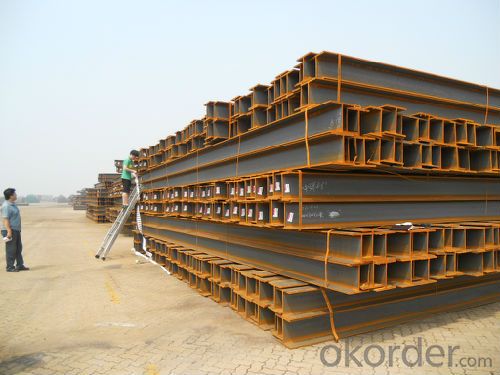
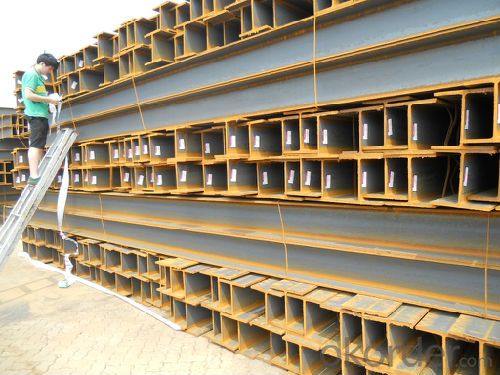
- Q: How do steel H-beams contribute to the overall functionality of a building?
- By offering structural support and stability, steel H-beams play a vital role in the overall functionality of a building. These beams are specifically designed to endure heavy loads and evenly distribute weight across the building's framework. One noteworthy contribution of steel H-beams is their capacity to span long distances without requiring intermediate support columns. As a result, they allow for open and flexible floor plans, eliminating the need for excessive interior columns and maximizing usable space within the building. Moreover, steel H-beams possess exceptional load-bearing capabilities, making them ideal for supporting multi-story structures. They can withstand external forces like wind, earthquakes, and heavy snow loads, ensuring the building's stability and safety. In addition, steel H-beams contribute to the overall functionality of a building by facilitating efficient construction. Because of their standardized shape and size, these beams can be easily manufactured and transported to the construction site. Furthermore, their lightweight nature reduces the overall weight of the building, resulting in cost savings in foundation and construction materials. Furthermore, steel H-beams are highly durable and resistant to corrosion, making them a long-lasting structural component. This durability guarantees the longevity of the building and minimizes the need for frequent maintenance or repairs. In conclusion, steel H-beams make significant contributions to the overall functionality of a building by providing structural support, stability, and design flexibility. Their ability to withstand heavy loads, span long distances, and resist external forces enhances the safety, efficiency, and longevity of the structure.
- Q: How do Steel H-Beams contribute to the overall natural ventilation of a structure?
- Steel H-Beams do not directly contribute to the natural ventilation of a structure. Natural ventilation refers to the process of using natural forces, such as wind and temperature differences, to circulate air within a building. However, Steel H-Beams can indirectly impact the natural ventilation of a structure by providing the necessary structural support for windows and openings. H-Beams are commonly used in construction to support the weight of the building and distribute it evenly. They are often used in the framework of a structure, allowing for the creation of large openings for windows or doors. These openings play a crucial role in natural ventilation as they allow fresh air to enter the building while allowing stale air to exit. By incorporating Steel H-Beams into the design of a structure, architects and engineers can create larger openings for windows and doors. This allows for increased airflow, enabling the natural ventilation process to be more effective. The H-Beams provide the necessary strength and stability to support these larger openings, ensuring the overall structural integrity of the building. In addition to supporting openings, Steel H-Beams can also be used to create roof structures that facilitate natural ventilation. By creating a pitched or sloped roof design, H-Beams can provide the necessary framework for the installation of vents or skylights. These features allow hot air to rise and escape, drawing in cooler air from lower levels and promoting natural airflow within the building. While Steel H-Beams themselves do not directly contribute to natural ventilation, their presence in the construction of a structure enables the incorporation of windows, doors, and other ventilation features. By providing the necessary structural support, Steel H-Beams play a vital role in enhancing the overall natural ventilation of a building.
- Q: Can steel H-beams be used in shopping mall structures?
- Yes, steel H-beams can be used in shopping mall structures. Steel H-beams are commonly used in the construction industry due to their strength, durability, and versatility. They provide excellent load-bearing capabilities, making them ideal for supporting the weight of large structures like shopping malls. Additionally, steel H-beams can be easily fabricated and installed, allowing for efficient construction processes. Overall, steel H-beams are a popular choice for shopping mall structures due to their structural integrity and ability to withstand heavy loads.
- Q: Can Steel H-Beams be used in museum or gallery construction?
- Yes, Steel H-Beams can be used in museum or gallery construction. Steel H-Beams are commonly used in construction due to their strength and durability. They provide structural support and can be used to create large open spaces, allowing for versatile and flexible designs. Additionally, they can be easily fabricated and installed, making them suitable for various architectural styles and requirements.
- Q: How are steel H-beams installed in construction projects?
- Steel H-beams are typically installed in construction projects by first determining the appropriate size and length of the beams needed for the structure. The beams are then lifted into position using cranes or other heavy machinery. They are aligned and secured to the support columns or walls using bolts, welding, or other metal connectors. This installation process ensures the beams provide structural support and stability to the building or project.
- Q: Are steel H-beams resistant to sound or noise transmission?
- Yes, steel H-beams have excellent resistance to sound or noise transmission due to their high mass and stiffness. They effectively dampen and absorb vibrations, reducing the transmission of sound waves through the structure.
- Q: How do steel H-beams provide structural support?
- Steel H-beams provide structural support by distributing the load evenly across their horizontal flanges and transferring it to the vertical web, which in turn transfers the load to the supporting columns or walls. This design allows for increased strength and stability, making H-beams an ideal choice for supporting heavy loads in various construction applications.
- Q: Are steel H-beams resistant to pests like termites?
- Steel H-beams possess a high level of resistance against pests such as termites. In contrast to wooden beams, which are prone to termite infestations, steel H-beams do not serve as a food source for termites nor create a suitable environment for their thriving. Termites primarily feed on cellulose, a substance present in wood. However, as steel is not composed of organic material, termites are not attracted to it. Furthermore, steel H-beams are impervious to moisture damage and decay, which are other factors that can attract and sustain termite colonies. Consequently, incorporating steel H-beams in construction markedly diminishes the risk of termite infestation and potential harm to the structure.
- Q: How is the weight of H steel calculated?
- H section steel is a kind of economical section high efficiency profile with more optimized sectional area distribution and stronger weight ratio. It is named after the English letter "H". Because all the sections of H steel are arranged at right angles, H steel has been widely used in all directions for its advantages of high bending resistance, simple construction, cost saving and light weight.
- Q: Are steel H-beams susceptible to corrosion?
- Yes, steel H-beams are susceptible to corrosion. However, their susceptibility to corrosion can be significantly reduced by applying protective coatings or using corrosion-resistant materials.
Send your message to us
Hot Rolled Steel H Beams for Construction of Structures
- Loading Port:
- Tianjin
- Payment Terms:
- TT or LC
- Min Order Qty:
- 50 m.t.
- Supply Capability:
- 10000 m.t./month
OKorder Service Pledge
OKorder Financial Service
Similar products
Hot products
Hot Searches
Related keywords
